Management of Business Contexts at Woolworths Supermarket Report
VerifiedAdded on 2022/08/24
|12
|2631
|16
Report
AI Summary
This report provides an in-depth analysis of Woolworths Supermarket's management of business contexts, focusing on real-world problem-solving. It examines the application of Customer Relationship Management (CRM) systems and social media platforms in addressing issues like changing customer preferences and employee turnover. The report further explores how Woolworths incorporates wider business contexts, including Human Resource Management (HRM), Corporate Social Responsibility (CSR), and risk management, into its operations. It highlights the importance of innovation and enterprise risk management strategies in aligning with market dynamics and ensuring environmental sustainability. The analysis draws on various research sources to demonstrate Woolworths' ability to integrate these factors effectively, ultimately contributing to its operational success. The report also includes a discussion on planning and conducting projects to solve management problems within Woolworths, with a focus on the importance of considering the broader business contexts and implications.

Running head: MANAGEMENT
Management of Business Contexts at Woolworths Supermarket
Name of the student
Name of the university
Author Note:
Management of Business Contexts at Woolworths Supermarket
Name of the student
Name of the university
Author Note:
Paraphrase This Document
Need a fresh take? Get an instant paraphrase of this document with our AI Paraphraser
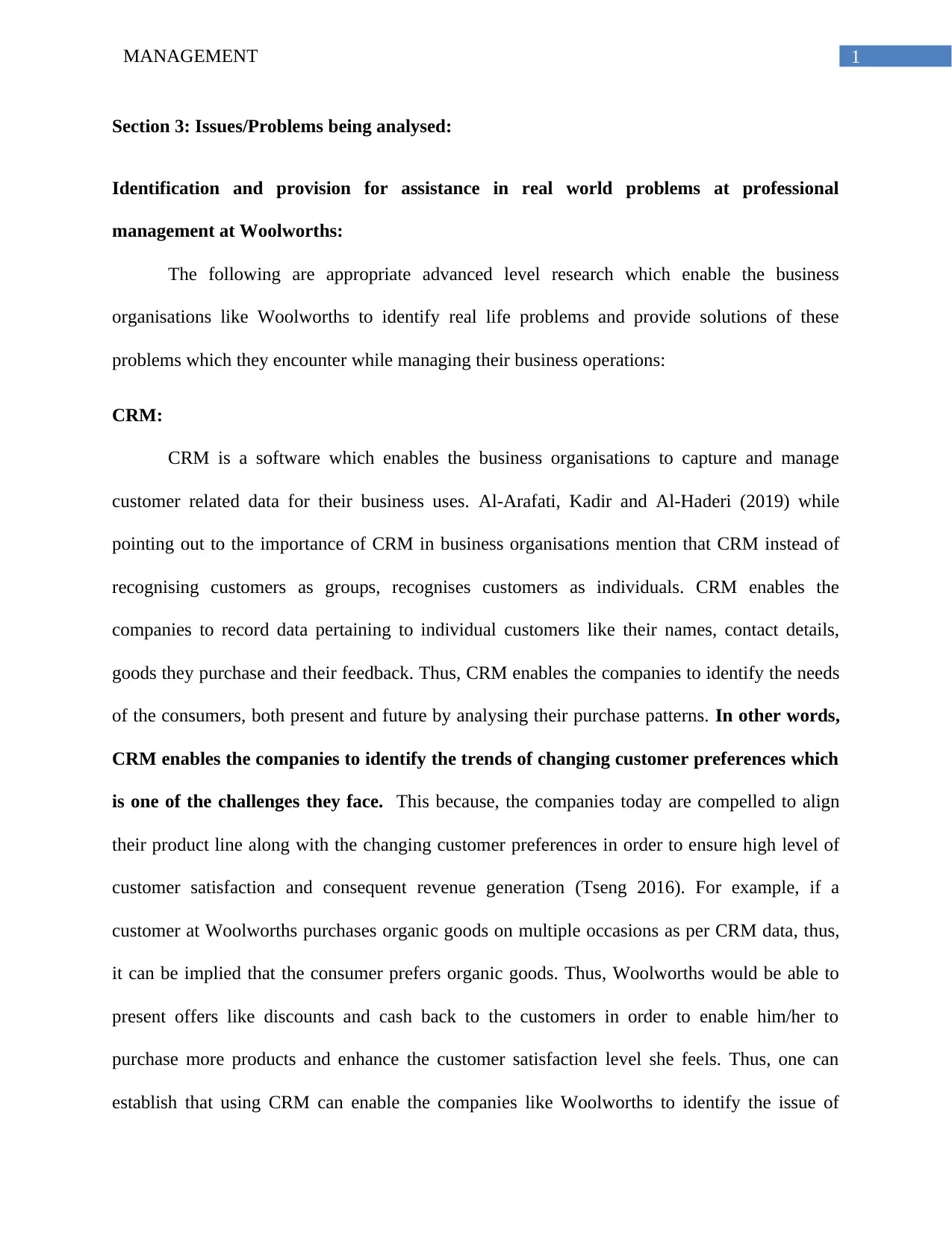
1MANAGEMENT
Section 3: Issues/Problems being analysed:
Identification and provision for assistance in real world problems at professional
management at Woolworths:
The following are appropriate advanced level research which enable the business
organisations like Woolworths to identify real life problems and provide solutions of these
problems which they encounter while managing their business operations:
CRM:
CRM is a software which enables the business organisations to capture and manage
customer related data for their business uses. Al-Arafati, Kadir and Al-Haderi (2019) while
pointing out to the importance of CRM in business organisations mention that CRM instead of
recognising customers as groups, recognises customers as individuals. CRM enables the
companies to record data pertaining to individual customers like their names, contact details,
goods they purchase and their feedback. Thus, CRM enables the companies to identify the needs
of the consumers, both present and future by analysing their purchase patterns. In other words,
CRM enables the companies to identify the trends of changing customer preferences which
is one of the challenges they face. This because, the companies today are compelled to align
their product line along with the changing customer preferences in order to ensure high level of
customer satisfaction and consequent revenue generation (Tseng 2016). For example, if a
customer at Woolworths purchases organic goods on multiple occasions as per CRM data, thus,
it can be implied that the consumer prefers organic goods. Thus, Woolworths would be able to
present offers like discounts and cash back to the customers in order to enable him/her to
purchase more products and enhance the customer satisfaction level she feels. Thus, one can
establish that using CRM can enable the companies like Woolworths to identify the issue of
Section 3: Issues/Problems being analysed:
Identification and provision for assistance in real world problems at professional
management at Woolworths:
The following are appropriate advanced level research which enable the business
organisations like Woolworths to identify real life problems and provide solutions of these
problems which they encounter while managing their business operations:
CRM:
CRM is a software which enables the business organisations to capture and manage
customer related data for their business uses. Al-Arafati, Kadir and Al-Haderi (2019) while
pointing out to the importance of CRM in business organisations mention that CRM instead of
recognising customers as groups, recognises customers as individuals. CRM enables the
companies to record data pertaining to individual customers like their names, contact details,
goods they purchase and their feedback. Thus, CRM enables the companies to identify the needs
of the consumers, both present and future by analysing their purchase patterns. In other words,
CRM enables the companies to identify the trends of changing customer preferences which
is one of the challenges they face. This because, the companies today are compelled to align
their product line along with the changing customer preferences in order to ensure high level of
customer satisfaction and consequent revenue generation (Tseng 2016). For example, if a
customer at Woolworths purchases organic goods on multiple occasions as per CRM data, thus,
it can be implied that the consumer prefers organic goods. Thus, Woolworths would be able to
present offers like discounts and cash back to the customers in order to enable him/her to
purchase more products and enhance the customer satisfaction level she feels. Thus, one can
establish that using CRM can enable the companies like Woolworths to identify the issue of

2MANAGEMENT
changing preferences of consumers and offer appropriate products to solve the issue to the
feasible extent.
Social media platforms:
Social media platforms enable the business organisations to identify several issues
pertaining to their business and in fact facilitate formation of strategies to deal with them to
extent possible. Wang and Kim (2017) while elaborating the importance of social media in
contexts of present business management, point out that social media platforms enable
organisations to improve relationship with their customers and employees. Becić, Stojanović and
Nikolić (2018) point out that business organisations can use social media platforms to market
their products and gain feedbacks on the same. The management can incorporate these feedbacks
while making business strategies. For example, Woolworths can post information about existing
and new products on its social media handles like Facebook and Instagram. This would enable
the consumers following these pages of the retail chain to express their feedbacks like
suggestions and criticisms on these products. The management of Woolworths would be able to
incorporate feedbacks from customers while forming future product strategies (Instagram.com.
2020). Similarly, the social media to some extent enable business organisations identify and deal
with the real problem of high employee turnover which they face today. van Zoonen and
Banghart (2018) point out that social media platforms provides a less formal platform to
employees. This encourages them to communicate more freely about their expectations and fears
pertaining to their jobs. The management can incorporate these feedback obtained from social
media platforms regarding employee communication and incorporate the same in the future
employee policies (Opitz, Chaudhri and Wang 2018). The outcome of these policies would be a
more employee centric organisational culture which enhance job satisfaction among employees.
changing preferences of consumers and offer appropriate products to solve the issue to the
feasible extent.
Social media platforms:
Social media platforms enable the business organisations to identify several issues
pertaining to their business and in fact facilitate formation of strategies to deal with them to
extent possible. Wang and Kim (2017) while elaborating the importance of social media in
contexts of present business management, point out that social media platforms enable
organisations to improve relationship with their customers and employees. Becić, Stojanović and
Nikolić (2018) point out that business organisations can use social media platforms to market
their products and gain feedbacks on the same. The management can incorporate these feedbacks
while making business strategies. For example, Woolworths can post information about existing
and new products on its social media handles like Facebook and Instagram. This would enable
the consumers following these pages of the retail chain to express their feedbacks like
suggestions and criticisms on these products. The management of Woolworths would be able to
incorporate feedbacks from customers while forming future product strategies (Instagram.com.
2020). Similarly, the social media to some extent enable business organisations identify and deal
with the real problem of high employee turnover which they face today. van Zoonen and
Banghart (2018) point out that social media platforms provides a less formal platform to
employees. This encourages them to communicate more freely about their expectations and fears
pertaining to their jobs. The management can incorporate these feedback obtained from social
media platforms regarding employee communication and incorporate the same in the future
employee policies (Opitz, Chaudhri and Wang 2018). The outcome of these policies would be a
more employee centric organisational culture which enhance job satisfaction among employees.
⊘ This is a preview!⊘
Do you want full access?
Subscribe today to unlock all pages.

Trusted by 1+ million students worldwide
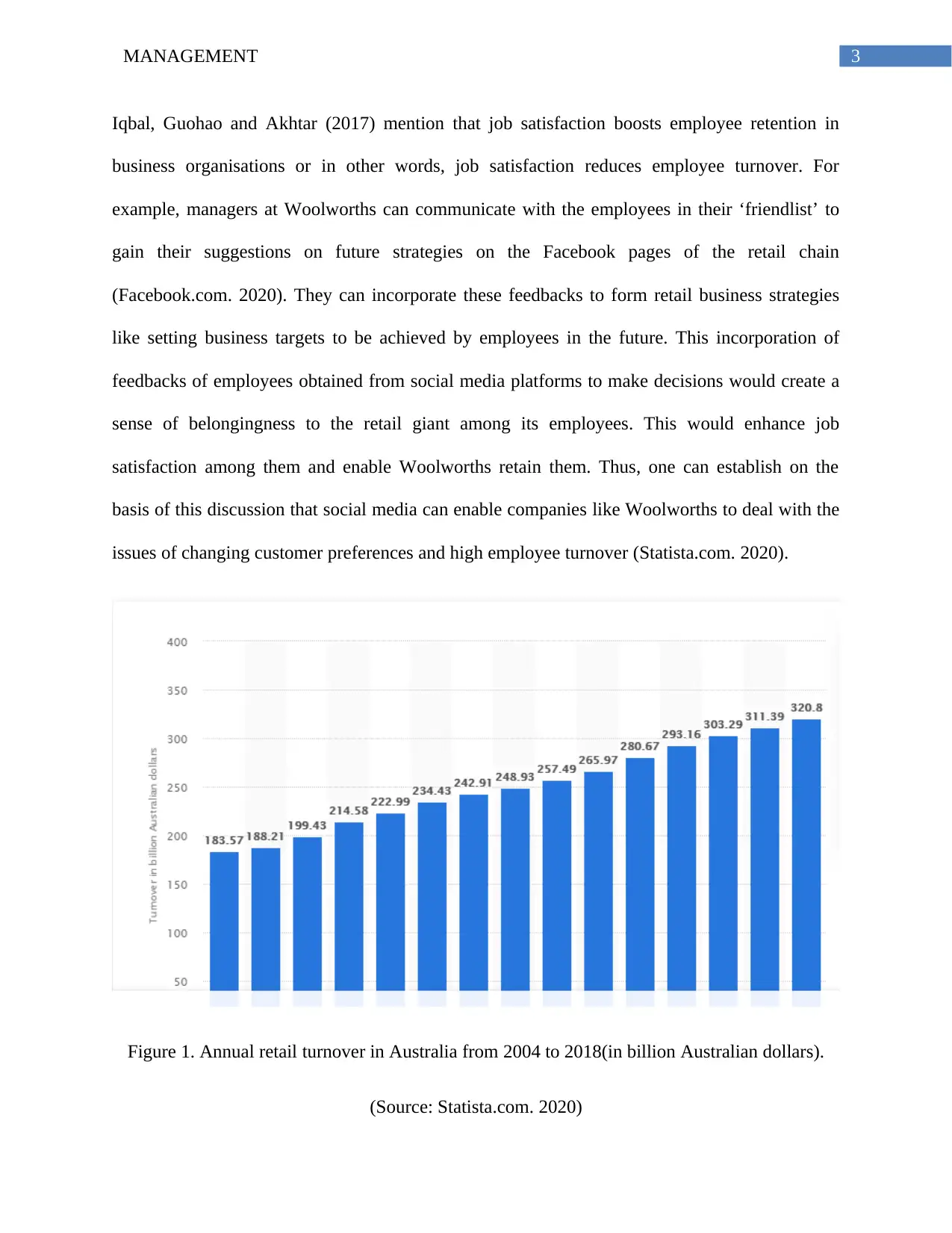
3MANAGEMENT
Iqbal, Guohao and Akhtar (2017) mention that job satisfaction boosts employee retention in
business organisations or in other words, job satisfaction reduces employee turnover. For
example, managers at Woolworths can communicate with the employees in their ‘friendlist’ to
gain their suggestions on future strategies on the Facebook pages of the retail chain
(Facebook.com. 2020). They can incorporate these feedbacks to form retail business strategies
like setting business targets to be achieved by employees in the future. This incorporation of
feedbacks of employees obtained from social media platforms to make decisions would create a
sense of belongingness to the retail giant among its employees. This would enhance job
satisfaction among them and enable Woolworths retain them. Thus, one can establish on the
basis of this discussion that social media can enable companies like Woolworths to deal with the
issues of changing customer preferences and high employee turnover (Statista.com. 2020).
Figure 1. Annual retail turnover in Australia from 2004 to 2018(in billion Australian dollars).
(Source: Statista.com. 2020)
Iqbal, Guohao and Akhtar (2017) mention that job satisfaction boosts employee retention in
business organisations or in other words, job satisfaction reduces employee turnover. For
example, managers at Woolworths can communicate with the employees in their ‘friendlist’ to
gain their suggestions on future strategies on the Facebook pages of the retail chain
(Facebook.com. 2020). They can incorporate these feedbacks to form retail business strategies
like setting business targets to be achieved by employees in the future. This incorporation of
feedbacks of employees obtained from social media platforms to make decisions would create a
sense of belongingness to the retail giant among its employees. This would enhance job
satisfaction among them and enable Woolworths retain them. Thus, one can establish on the
basis of this discussion that social media can enable companies like Woolworths to deal with the
issues of changing customer preferences and high employee turnover (Statista.com. 2020).
Figure 1. Annual retail turnover in Australia from 2004 to 2018(in billion Australian dollars).
(Source: Statista.com. 2020)
Paraphrase This Document
Need a fresh take? Get an instant paraphrase of this document with our AI Paraphraser
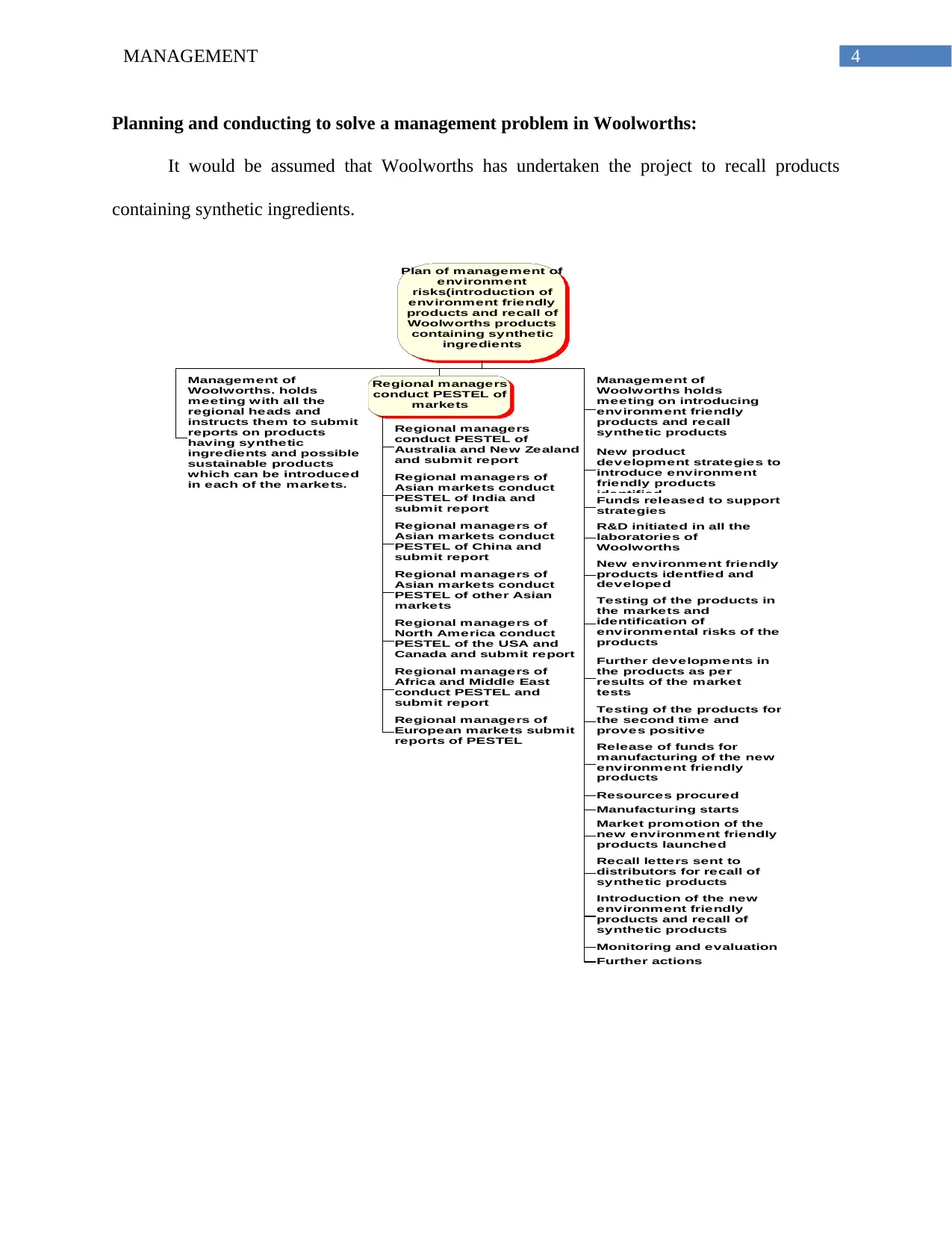
4MANAGEMENT
Planning and conducting to solve a management problem in Woolworths:
It would be assumed that Woolworths has undertaken the project to recall products
containing synthetic ingredients.
Plan of management of
environment
risks(introduction of
environment friendly
products and recall of
Woolworths products
containing synthetic
ingredients
Management of
Woolworths. holds
meeting with all the
regional heads and
instructs them to submit
reports on products
having synthetic
ingredients and possible
sustainable products
which can be introduced
in each of the markets.
Regional managers
conduct PESTEL of
markets
Regional managers
conduct PESTEL of
Australia and New Zealand
and submit report
Regional managers of
Asian markets conduct
PESTEL of India and
submit report
Regional managers of
Asian markets conduct
PESTEL of China and
submit report
Regional managers of
Asian markets conduct
PESTEL of other Asian
markets
Regional managers of
North America conduct
PESTEL of the USA and
Canada and submit report
Regional managers of
Africa and Middle East
conduct PESTEL and
submit report
Regional managers of
European markets submit
reports of PESTEL
Management of
Woolworths holds
meeting on introducing
environment friendly
products and recall
synthetic products
New product
development strategies to
introduce environment
friendly products
identified
Funds released to support
strategies
R&D initiated in all the
laboratories of
Woolworths
New environment friendly
products identfied and
developed
Testing of the products in
the markets and
identification of
environmental risks of the
products
Further developments in
the products as per
results of the market
tests
Testing of the products for
the second time and
proves positive
Release of funds for
manufacturing of the new
environment friendly
products
Resources procured
Manufacturing starts
Market promotion of the
new environment friendly
products launched
Recall letters sent to
distributors for recall of
synthetic products
Introduction of the new
environment friendly
products and recall of
synthetic products
Monitoring and evaluation
Further actions
Planning and conducting to solve a management problem in Woolworths:
It would be assumed that Woolworths has undertaken the project to recall products
containing synthetic ingredients.
Plan of management of
environment
risks(introduction of
environment friendly
products and recall of
Woolworths products
containing synthetic
ingredients
Management of
Woolworths. holds
meeting with all the
regional heads and
instructs them to submit
reports on products
having synthetic
ingredients and possible
sustainable products
which can be introduced
in each of the markets.
Regional managers
conduct PESTEL of
markets
Regional managers
conduct PESTEL of
Australia and New Zealand
and submit report
Regional managers of
Asian markets conduct
PESTEL of India and
submit report
Regional managers of
Asian markets conduct
PESTEL of China and
submit report
Regional managers of
Asian markets conduct
PESTEL of other Asian
markets
Regional managers of
North America conduct
PESTEL of the USA and
Canada and submit report
Regional managers of
Africa and Middle East
conduct PESTEL and
submit report
Regional managers of
European markets submit
reports of PESTEL
Management of
Woolworths holds
meeting on introducing
environment friendly
products and recall
synthetic products
New product
development strategies to
introduce environment
friendly products
identified
Funds released to support
strategies
R&D initiated in all the
laboratories of
Woolworths
New environment friendly
products identfied and
developed
Testing of the products in
the markets and
identification of
environmental risks of the
products
Further developments in
the products as per
results of the market
tests
Testing of the products for
the second time and
proves positive
Release of funds for
manufacturing of the new
environment friendly
products
Resources procured
Manufacturing starts
Market promotion of the
new environment friendly
products launched
Recall letters sent to
distributors for recall of
synthetic products
Introduction of the new
environment friendly
products and recall of
synthetic products
Monitoring and evaluation
Further actions
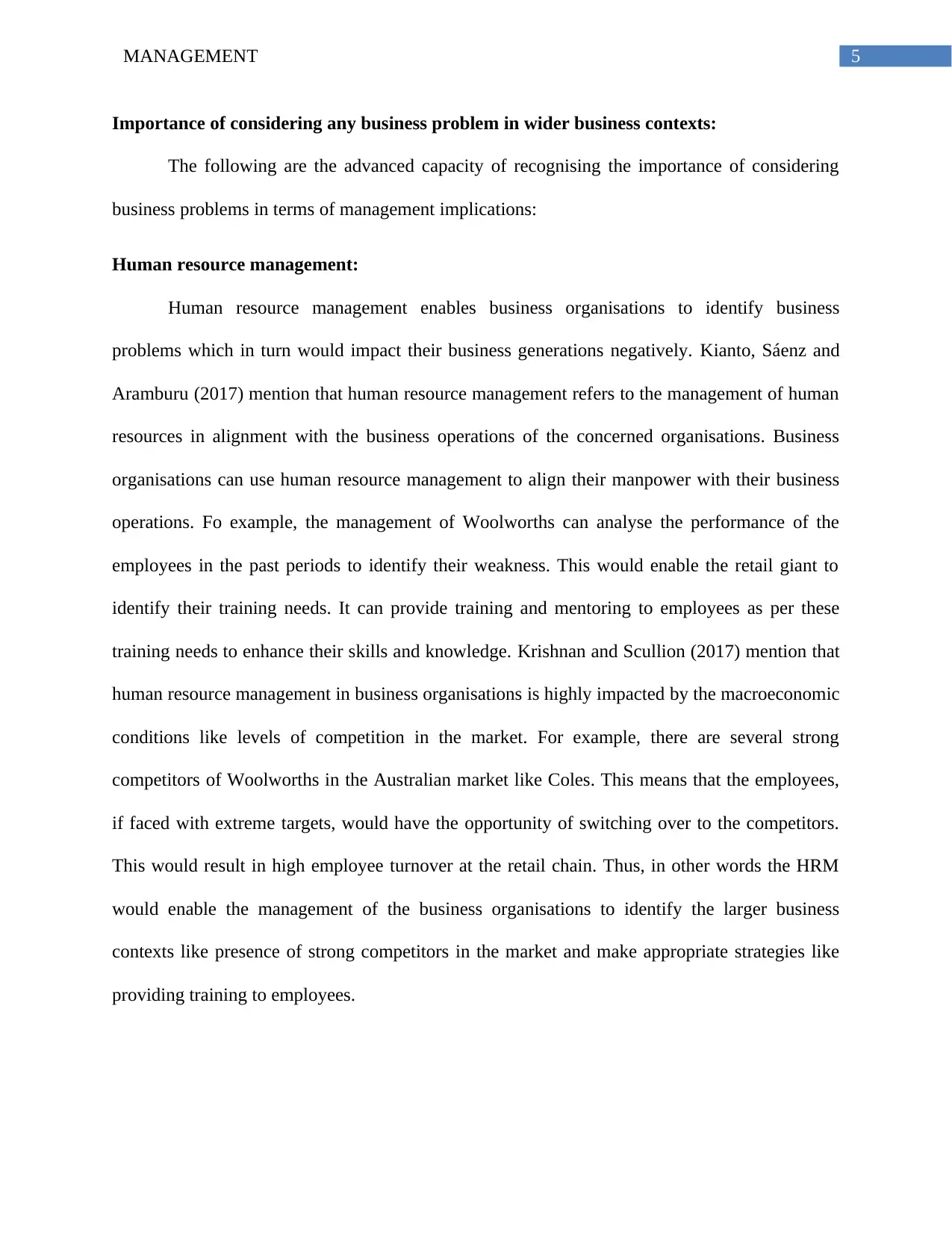
5MANAGEMENT
Importance of considering any business problem in wider business contexts:
The following are the advanced capacity of recognising the importance of considering
business problems in terms of management implications:
Human resource management:
Human resource management enables business organisations to identify business
problems which in turn would impact their business generations negatively. Kianto, Sáenz and
Aramburu (2017) mention that human resource management refers to the management of human
resources in alignment with the business operations of the concerned organisations. Business
organisations can use human resource management to align their manpower with their business
operations. Fo example, the management of Woolworths can analyse the performance of the
employees in the past periods to identify their weakness. This would enable the retail giant to
identify their training needs. It can provide training and mentoring to employees as per these
training needs to enhance their skills and knowledge. Krishnan and Scullion (2017) mention that
human resource management in business organisations is highly impacted by the macroeconomic
conditions like levels of competition in the market. For example, there are several strong
competitors of Woolworths in the Australian market like Coles. This means that the employees,
if faced with extreme targets, would have the opportunity of switching over to the competitors.
This would result in high employee turnover at the retail chain. Thus, in other words the HRM
would enable the management of the business organisations to identify the larger business
contexts like presence of strong competitors in the market and make appropriate strategies like
providing training to employees.
Importance of considering any business problem in wider business contexts:
The following are the advanced capacity of recognising the importance of considering
business problems in terms of management implications:
Human resource management:
Human resource management enables business organisations to identify business
problems which in turn would impact their business generations negatively. Kianto, Sáenz and
Aramburu (2017) mention that human resource management refers to the management of human
resources in alignment with the business operations of the concerned organisations. Business
organisations can use human resource management to align their manpower with their business
operations. Fo example, the management of Woolworths can analyse the performance of the
employees in the past periods to identify their weakness. This would enable the retail giant to
identify their training needs. It can provide training and mentoring to employees as per these
training needs to enhance their skills and knowledge. Krishnan and Scullion (2017) mention that
human resource management in business organisations is highly impacted by the macroeconomic
conditions like levels of competition in the market. For example, there are several strong
competitors of Woolworths in the Australian market like Coles. This means that the employees,
if faced with extreme targets, would have the opportunity of switching over to the competitors.
This would result in high employee turnover at the retail chain. Thus, in other words the HRM
would enable the management of the business organisations to identify the larger business
contexts like presence of strong competitors in the market and make appropriate strategies like
providing training to employees.
⊘ This is a preview!⊘
Do you want full access?
Subscribe today to unlock all pages.

Trusted by 1+ million students worldwide
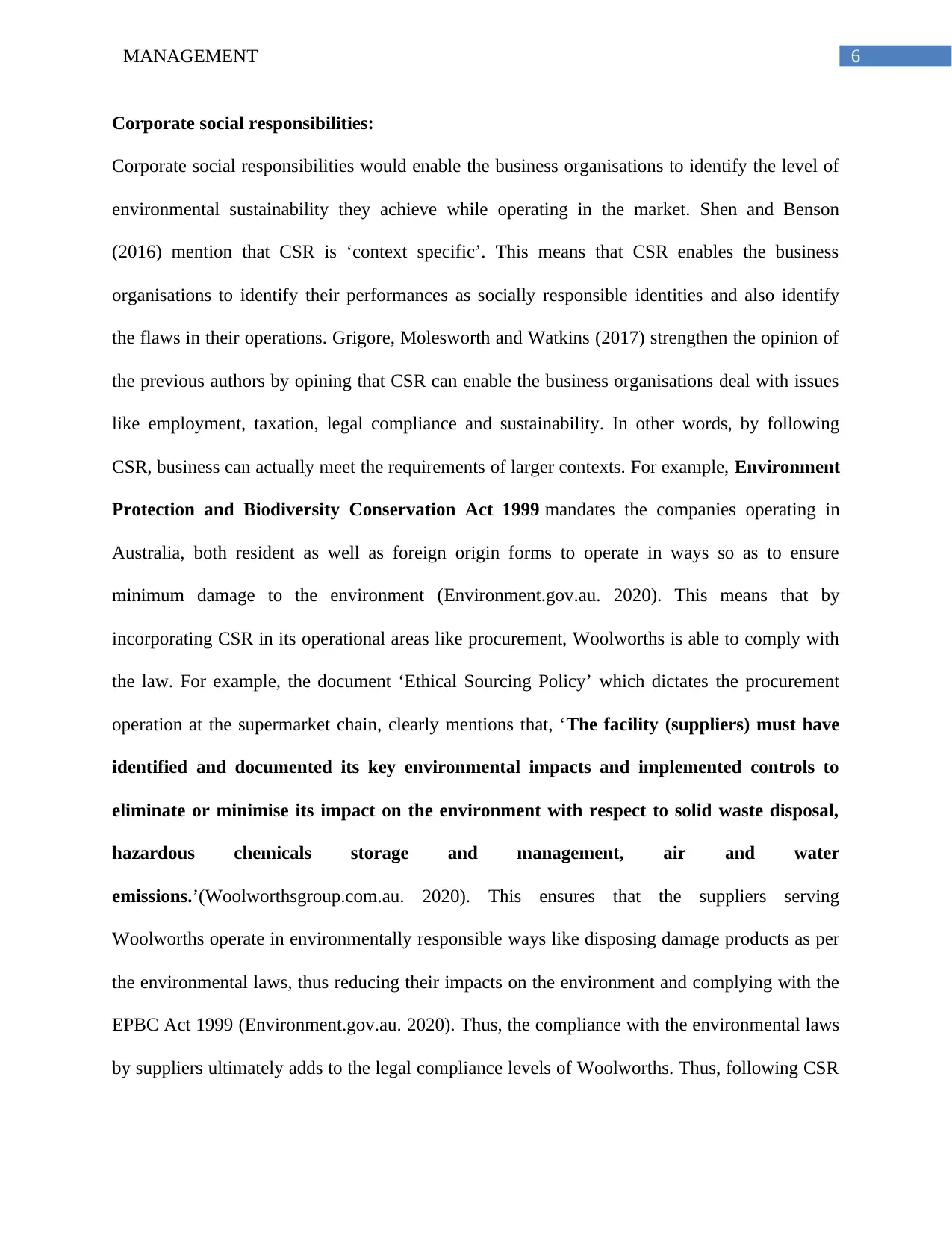
6MANAGEMENT
Corporate social responsibilities:
Corporate social responsibilities would enable the business organisations to identify the level of
environmental sustainability they achieve while operating in the market. Shen and Benson
(2016) mention that CSR is ‘context specific’. This means that CSR enables the business
organisations to identify their performances as socially responsible identities and also identify
the flaws in their operations. Grigore, Molesworth and Watkins (2017) strengthen the opinion of
the previous authors by opining that CSR can enable the business organisations deal with issues
like employment, taxation, legal compliance and sustainability. In other words, by following
CSR, business can actually meet the requirements of larger contexts. For example, Environment
Protection and Biodiversity Conservation Act 1999 mandates the companies operating in
Australia, both resident as well as foreign origin forms to operate in ways so as to ensure
minimum damage to the environment (Environment.gov.au. 2020). This means that by
incorporating CSR in its operational areas like procurement, Woolworths is able to comply with
the law. For example, the document ‘Ethical Sourcing Policy’ which dictates the procurement
operation at the supermarket chain, clearly mentions that, ‘The facility (suppliers) must have
identified and documented its key environmental impacts and implemented controls to
eliminate or minimise its impact on the environment with respect to solid waste disposal,
hazardous chemicals storage and management, air and water
emissions.’(Woolworthsgroup.com.au. 2020). This ensures that the suppliers serving
Woolworths operate in environmentally responsible ways like disposing damage products as per
the environmental laws, thus reducing their impacts on the environment and complying with the
EPBC Act 1999 (Environment.gov.au. 2020). Thus, the compliance with the environmental laws
by suppliers ultimately adds to the legal compliance levels of Woolworths. Thus, following CSR
Corporate social responsibilities:
Corporate social responsibilities would enable the business organisations to identify the level of
environmental sustainability they achieve while operating in the market. Shen and Benson
(2016) mention that CSR is ‘context specific’. This means that CSR enables the business
organisations to identify their performances as socially responsible identities and also identify
the flaws in their operations. Grigore, Molesworth and Watkins (2017) strengthen the opinion of
the previous authors by opining that CSR can enable the business organisations deal with issues
like employment, taxation, legal compliance and sustainability. In other words, by following
CSR, business can actually meet the requirements of larger contexts. For example, Environment
Protection and Biodiversity Conservation Act 1999 mandates the companies operating in
Australia, both resident as well as foreign origin forms to operate in ways so as to ensure
minimum damage to the environment (Environment.gov.au. 2020). This means that by
incorporating CSR in its operational areas like procurement, Woolworths is able to comply with
the law. For example, the document ‘Ethical Sourcing Policy’ which dictates the procurement
operation at the supermarket chain, clearly mentions that, ‘The facility (suppliers) must have
identified and documented its key environmental impacts and implemented controls to
eliminate or minimise its impact on the environment with respect to solid waste disposal,
hazardous chemicals storage and management, air and water
emissions.’(Woolworthsgroup.com.au. 2020). This ensures that the suppliers serving
Woolworths operate in environmentally responsible ways like disposing damage products as per
the environmental laws, thus reducing their impacts on the environment and complying with the
EPBC Act 1999 (Environment.gov.au. 2020). Thus, the compliance with the environmental laws
by suppliers ultimately adds to the legal compliance levels of Woolworths. Thus, following CSR
Paraphrase This Document
Need a fresh take? Get an instant paraphrase of this document with our AI Paraphraser

7MANAGEMENT
enables business organisations like Woolworths to ensure two separate business contexts namely,
legal compliance and supply chain management (Perry and Wood 2018).
Demonstration of ability of Woolworths to incorporate wider business contexts
implications in its management operations:
Woolworths Supermarkets is able to demonstrate ability in incorporating wider business
contexts in its operations while operating in the market. The following aspects of the Australian
retail giant would establish its capabilities of incorporating wider business contexts like risk
management in its operations:
Enterprise Risk management strategies:
Risk management is an important aspect which business organisations like Woolworths
have to consider in order to operate in the market. Shad et al. (2019) mention that business
organisations have to respond to market risks by forming strong ERM strategies. They also
mention that business organisations face risks owing to changes in the macroeconomic contexts
like political changes and changes in the preferences of goods among the customers in the
society. In other ERM connects the operations of the business organisations to the larger market
contexts like changes in laws and emergence of new competitors, which amount to risks before
these organisations. The ‘Group Risk Management Policy’ of Woolworths shows it aims to
‘effectively managing its risks, which creates shareholder value and protects our people,
customers and assets.’ (Woolworthsgroup.com.au. 2020). This shows that the retail giant is
capable of responding to wide market contexts using its ERM.
enables business organisations like Woolworths to ensure two separate business contexts namely,
legal compliance and supply chain management (Perry and Wood 2018).
Demonstration of ability of Woolworths to incorporate wider business contexts
implications in its management operations:
Woolworths Supermarkets is able to demonstrate ability in incorporating wider business
contexts in its operations while operating in the market. The following aspects of the Australian
retail giant would establish its capabilities of incorporating wider business contexts like risk
management in its operations:
Enterprise Risk management strategies:
Risk management is an important aspect which business organisations like Woolworths
have to consider in order to operate in the market. Shad et al. (2019) mention that business
organisations have to respond to market risks by forming strong ERM strategies. They also
mention that business organisations face risks owing to changes in the macroeconomic contexts
like political changes and changes in the preferences of goods among the customers in the
society. In other ERM connects the operations of the business organisations to the larger market
contexts like changes in laws and emergence of new competitors, which amount to risks before
these organisations. The ‘Group Risk Management Policy’ of Woolworths shows it aims to
‘effectively managing its risks, which creates shareholder value and protects our people,
customers and assets.’ (Woolworthsgroup.com.au. 2020). This shows that the retail giant is
capable of responding to wide market contexts using its ERM.
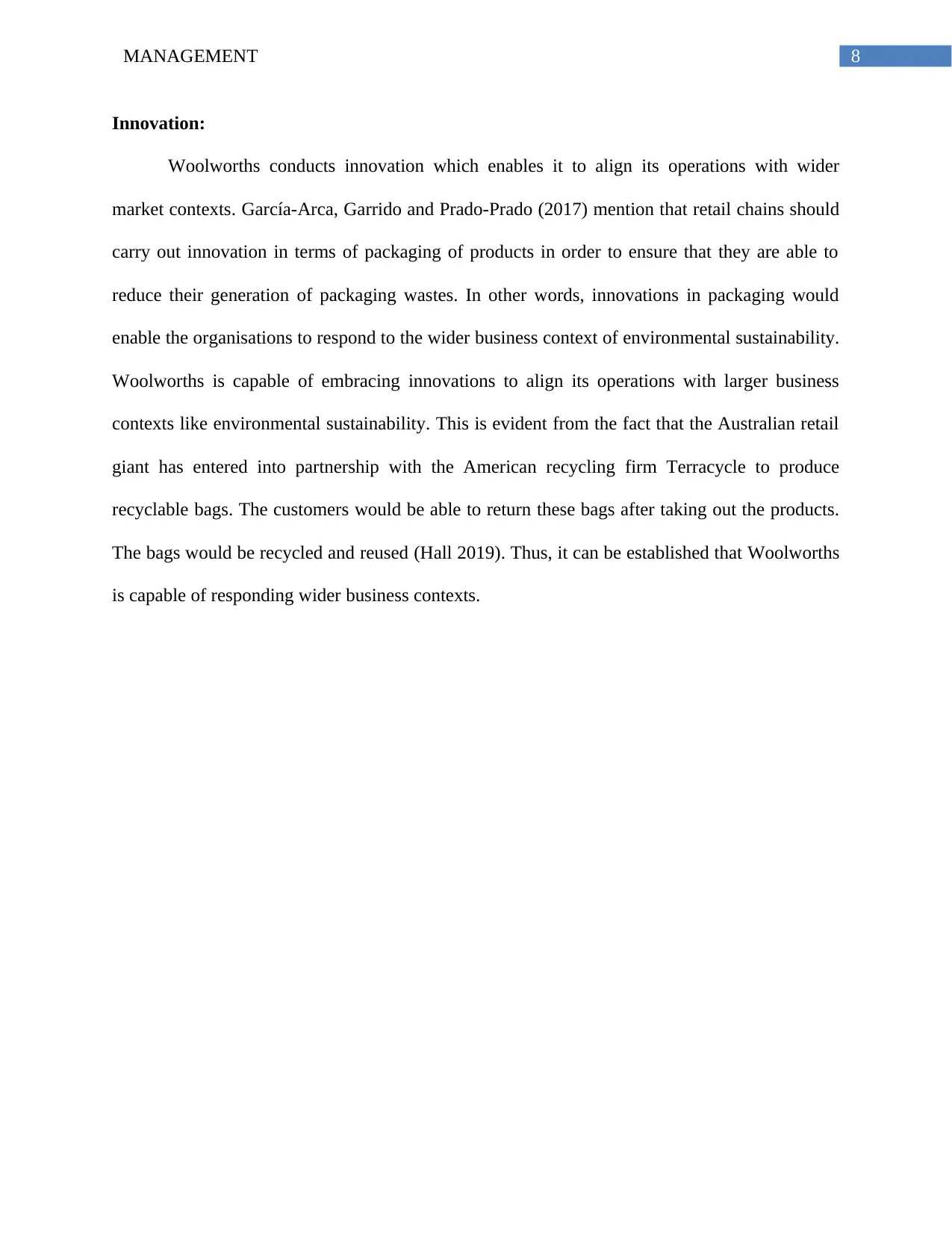
8MANAGEMENT
Innovation:
Woolworths conducts innovation which enables it to align its operations with wider
market contexts. García-Arca, Garrido and Prado-Prado (2017) mention that retail chains should
carry out innovation in terms of packaging of products in order to ensure that they are able to
reduce their generation of packaging wastes. In other words, innovations in packaging would
enable the organisations to respond to the wider business context of environmental sustainability.
Woolworths is capable of embracing innovations to align its operations with larger business
contexts like environmental sustainability. This is evident from the fact that the Australian retail
giant has entered into partnership with the American recycling firm Terracycle to produce
recyclable bags. The customers would be able to return these bags after taking out the products.
The bags would be recycled and reused (Hall 2019). Thus, it can be established that Woolworths
is capable of responding wider business contexts.
Innovation:
Woolworths conducts innovation which enables it to align its operations with wider
market contexts. García-Arca, Garrido and Prado-Prado (2017) mention that retail chains should
carry out innovation in terms of packaging of products in order to ensure that they are able to
reduce their generation of packaging wastes. In other words, innovations in packaging would
enable the organisations to respond to the wider business context of environmental sustainability.
Woolworths is capable of embracing innovations to align its operations with larger business
contexts like environmental sustainability. This is evident from the fact that the Australian retail
giant has entered into partnership with the American recycling firm Terracycle to produce
recyclable bags. The customers would be able to return these bags after taking out the products.
The bags would be recycled and reused (Hall 2019). Thus, it can be established that Woolworths
is capable of responding wider business contexts.
⊘ This is a preview!⊘
Do you want full access?
Subscribe today to unlock all pages.

Trusted by 1+ million students worldwide
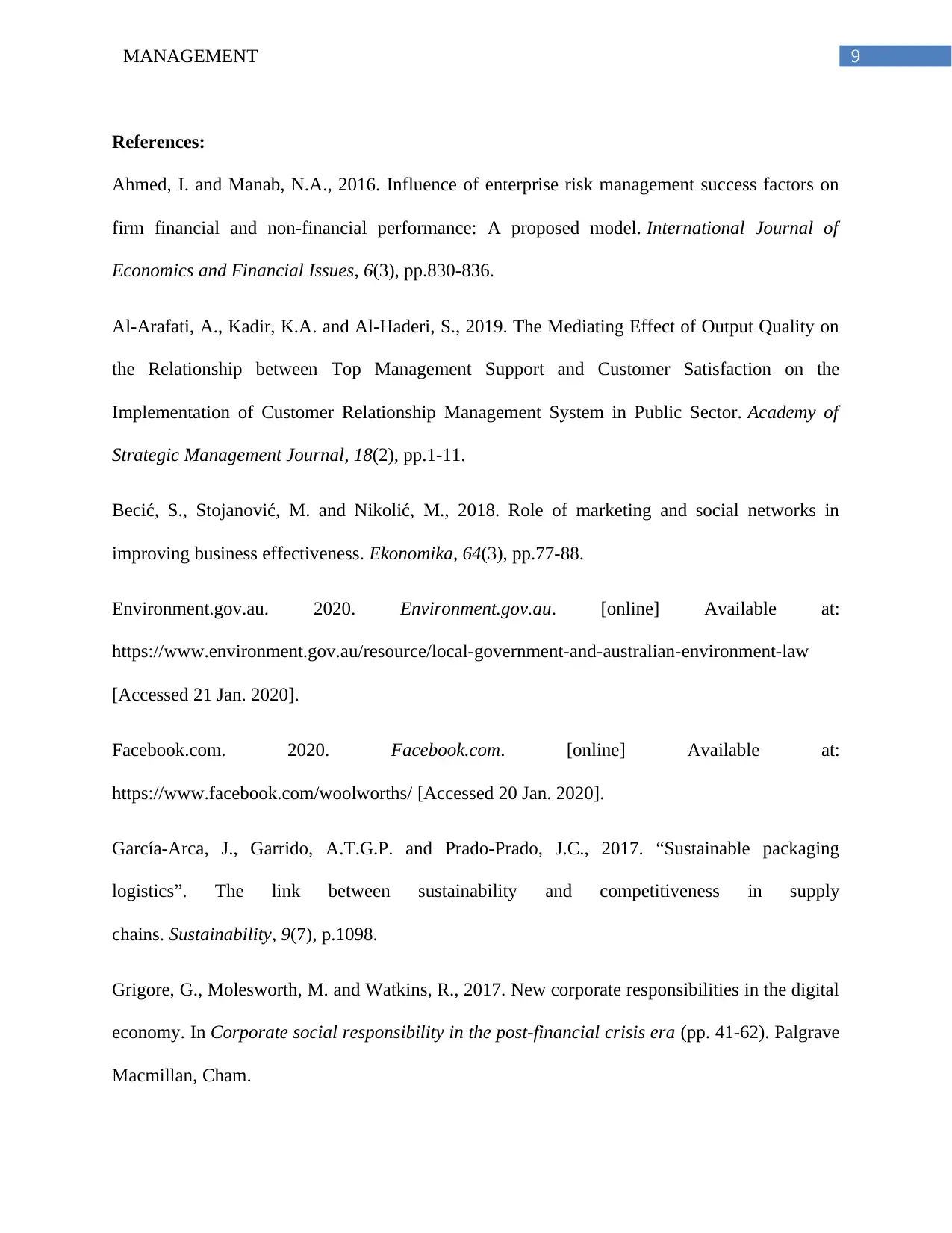
9MANAGEMENT
References:
Ahmed, I. and Manab, N.A., 2016. Influence of enterprise risk management success factors on
firm financial and non-financial performance: A proposed model. International Journal of
Economics and Financial Issues, 6(3), pp.830-836.
Al-Arafati, A., Kadir, K.A. and Al-Haderi, S., 2019. The Mediating Effect of Output Quality on
the Relationship between Top Management Support and Customer Satisfaction on the
Implementation of Customer Relationship Management System in Public Sector. Academy of
Strategic Management Journal, 18(2), pp.1-11.
Becić, S., Stojanović, M. and Nikolić, M., 2018. Role of marketing and social networks in
improving business effectiveness. Ekonomika, 64(3), pp.77-88.
Environment.gov.au. 2020. Environment.gov.au. [online] Available at:
https://www.environment.gov.au/resource/local-government-and-australian-environment-law
[Accessed 21 Jan. 2020].
Facebook.com. 2020. Facebook.com. [online] Available at:
https://www.facebook.com/woolworths/ [Accessed 20 Jan. 2020].
García-Arca, J., Garrido, A.T.G.P. and Prado-Prado, J.C., 2017. “Sustainable packaging
logistics”. The link between sustainability and competitiveness in supply
chains. Sustainability, 9(7), p.1098.
Grigore, G., Molesworth, M. and Watkins, R., 2017. New corporate responsibilities in the digital
economy. In Corporate social responsibility in the post-financial crisis era (pp. 41-62). Palgrave
Macmillan, Cham.
References:
Ahmed, I. and Manab, N.A., 2016. Influence of enterprise risk management success factors on
firm financial and non-financial performance: A proposed model. International Journal of
Economics and Financial Issues, 6(3), pp.830-836.
Al-Arafati, A., Kadir, K.A. and Al-Haderi, S., 2019. The Mediating Effect of Output Quality on
the Relationship between Top Management Support and Customer Satisfaction on the
Implementation of Customer Relationship Management System in Public Sector. Academy of
Strategic Management Journal, 18(2), pp.1-11.
Becić, S., Stojanović, M. and Nikolić, M., 2018. Role of marketing and social networks in
improving business effectiveness. Ekonomika, 64(3), pp.77-88.
Environment.gov.au. 2020. Environment.gov.au. [online] Available at:
https://www.environment.gov.au/resource/local-government-and-australian-environment-law
[Accessed 21 Jan. 2020].
Facebook.com. 2020. Facebook.com. [online] Available at:
https://www.facebook.com/woolworths/ [Accessed 20 Jan. 2020].
García-Arca, J., Garrido, A.T.G.P. and Prado-Prado, J.C., 2017. “Sustainable packaging
logistics”. The link between sustainability and competitiveness in supply
chains. Sustainability, 9(7), p.1098.
Grigore, G., Molesworth, M. and Watkins, R., 2017. New corporate responsibilities in the digital
economy. In Corporate social responsibility in the post-financial crisis era (pp. 41-62). Palgrave
Macmillan, Cham.
Paraphrase This Document
Need a fresh take? Get an instant paraphrase of this document with our AI Paraphraser
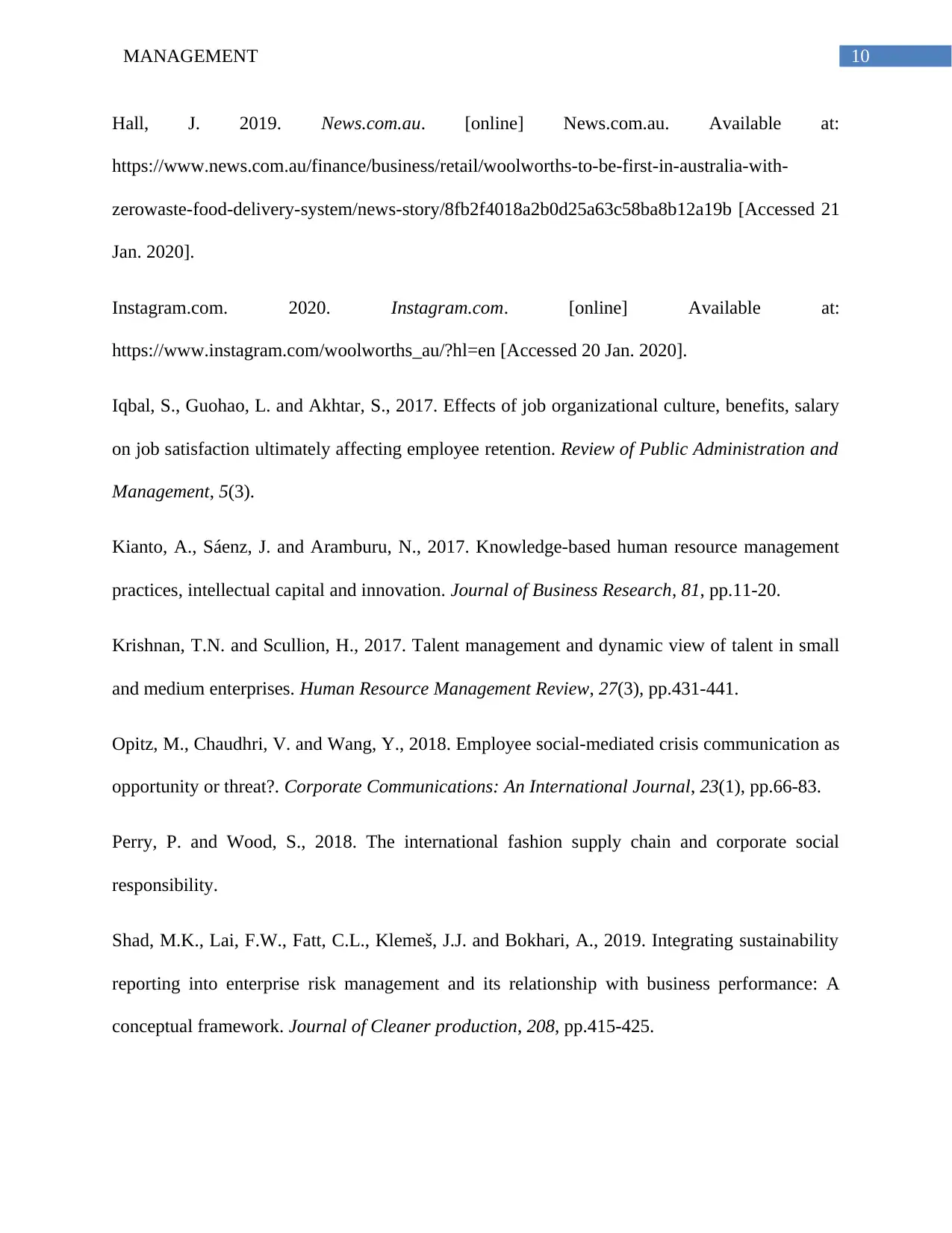
10MANAGEMENT
Hall, J. 2019. News.com.au. [online] News.com.au. Available at:
https://www.news.com.au/finance/business/retail/woolworths-to-be-first-in-australia-with-
zerowaste-food-delivery-system/news-story/8fb2f4018a2b0d25a63c58ba8b12a19b [Accessed 21
Jan. 2020].
Instagram.com. 2020. Instagram.com. [online] Available at:
https://www.instagram.com/woolworths_au/?hl=en [Accessed 20 Jan. 2020].
Iqbal, S., Guohao, L. and Akhtar, S., 2017. Effects of job organizational culture, benefits, salary
on job satisfaction ultimately affecting employee retention. Review of Public Administration and
Management, 5(3).
Kianto, A., Sáenz, J. and Aramburu, N., 2017. Knowledge-based human resource management
practices, intellectual capital and innovation. Journal of Business Research, 81, pp.11-20.
Krishnan, T.N. and Scullion, H., 2017. Talent management and dynamic view of talent in small
and medium enterprises. Human Resource Management Review, 27(3), pp.431-441.
Opitz, M., Chaudhri, V. and Wang, Y., 2018. Employee social-mediated crisis communication as
opportunity or threat?. Corporate Communications: An International Journal, 23(1), pp.66-83.
Perry, P. and Wood, S., 2018. The international fashion supply chain and corporate social
responsibility.
Shad, M.K., Lai, F.W., Fatt, C.L., Klemeš, J.J. and Bokhari, A., 2019. Integrating sustainability
reporting into enterprise risk management and its relationship with business performance: A
conceptual framework. Journal of Cleaner production, 208, pp.415-425.
Hall, J. 2019. News.com.au. [online] News.com.au. Available at:
https://www.news.com.au/finance/business/retail/woolworths-to-be-first-in-australia-with-
zerowaste-food-delivery-system/news-story/8fb2f4018a2b0d25a63c58ba8b12a19b [Accessed 21
Jan. 2020].
Instagram.com. 2020. Instagram.com. [online] Available at:
https://www.instagram.com/woolworths_au/?hl=en [Accessed 20 Jan. 2020].
Iqbal, S., Guohao, L. and Akhtar, S., 2017. Effects of job organizational culture, benefits, salary
on job satisfaction ultimately affecting employee retention. Review of Public Administration and
Management, 5(3).
Kianto, A., Sáenz, J. and Aramburu, N., 2017. Knowledge-based human resource management
practices, intellectual capital and innovation. Journal of Business Research, 81, pp.11-20.
Krishnan, T.N. and Scullion, H., 2017. Talent management and dynamic view of talent in small
and medium enterprises. Human Resource Management Review, 27(3), pp.431-441.
Opitz, M., Chaudhri, V. and Wang, Y., 2018. Employee social-mediated crisis communication as
opportunity or threat?. Corporate Communications: An International Journal, 23(1), pp.66-83.
Perry, P. and Wood, S., 2018. The international fashion supply chain and corporate social
responsibility.
Shad, M.K., Lai, F.W., Fatt, C.L., Klemeš, J.J. and Bokhari, A., 2019. Integrating sustainability
reporting into enterprise risk management and its relationship with business performance: A
conceptual framework. Journal of Cleaner production, 208, pp.415-425.

11MANAGEMENT
Shen, J. and Benson, J., 2016. When CSR is a social norm: How socially responsible human
resource management affects employee work behavior. Journal of Management, 42(6), pp.1723-
1746.
Statista.com. 2020. Statista.com. [online] Available at:
https://www.statista.com/statistics/653638/australia-annual-retail-turnover/ [Accessed 20 Jan.
2020].
Tseng, S.M., 2016. Knowledge management capability, customer relationship management, and
service quality. Journal of enterprise information management, 29(2), pp.202-221.
van Zoonen, W. and Banghart, S., 2018. Talking engagement into being: A three-wave panel
study linking boundary management preferences, work communication on social media, and
employee engagement. Journal of computer-mediated communication, 23(5), pp.278-293.
Wang, Z. and Kim, H.G., 2017. Can social media marketing improve customer relationship
capabilities and firm performance? Dynamic capability perspective. Journal of Interactive
Marketing, 39, pp.15-26.
Woolworthsgroup.com.au. 2020. Woolworthsgroup.com.au. [online] Available at:
https://www.woolworthsgroup.com.au/content/Document/Ethical%20Sourcing%20Policy.pdf
[Accessed 21 Jan. 2020].
Shen, J. and Benson, J., 2016. When CSR is a social norm: How socially responsible human
resource management affects employee work behavior. Journal of Management, 42(6), pp.1723-
1746.
Statista.com. 2020. Statista.com. [online] Available at:
https://www.statista.com/statistics/653638/australia-annual-retail-turnover/ [Accessed 20 Jan.
2020].
Tseng, S.M., 2016. Knowledge management capability, customer relationship management, and
service quality. Journal of enterprise information management, 29(2), pp.202-221.
van Zoonen, W. and Banghart, S., 2018. Talking engagement into being: A three-wave panel
study linking boundary management preferences, work communication on social media, and
employee engagement. Journal of computer-mediated communication, 23(5), pp.278-293.
Wang, Z. and Kim, H.G., 2017. Can social media marketing improve customer relationship
capabilities and firm performance? Dynamic capability perspective. Journal of Interactive
Marketing, 39, pp.15-26.
Woolworthsgroup.com.au. 2020. Woolworthsgroup.com.au. [online] Available at:
https://www.woolworthsgroup.com.au/content/Document/Ethical%20Sourcing%20Policy.pdf
[Accessed 21 Jan. 2020].
⊘ This is a preview!⊘
Do you want full access?
Subscribe today to unlock all pages.

Trusted by 1+ million students worldwide
1 out of 12
Related Documents
Your All-in-One AI-Powered Toolkit for Academic Success.
+13062052269
info@desklib.com
Available 24*7 on WhatsApp / Email
![[object Object]](/_next/static/media/star-bottom.7253800d.svg)
Unlock your academic potential
Copyright © 2020–2025 A2Z Services. All Rights Reserved. Developed and managed by ZUCOL.





